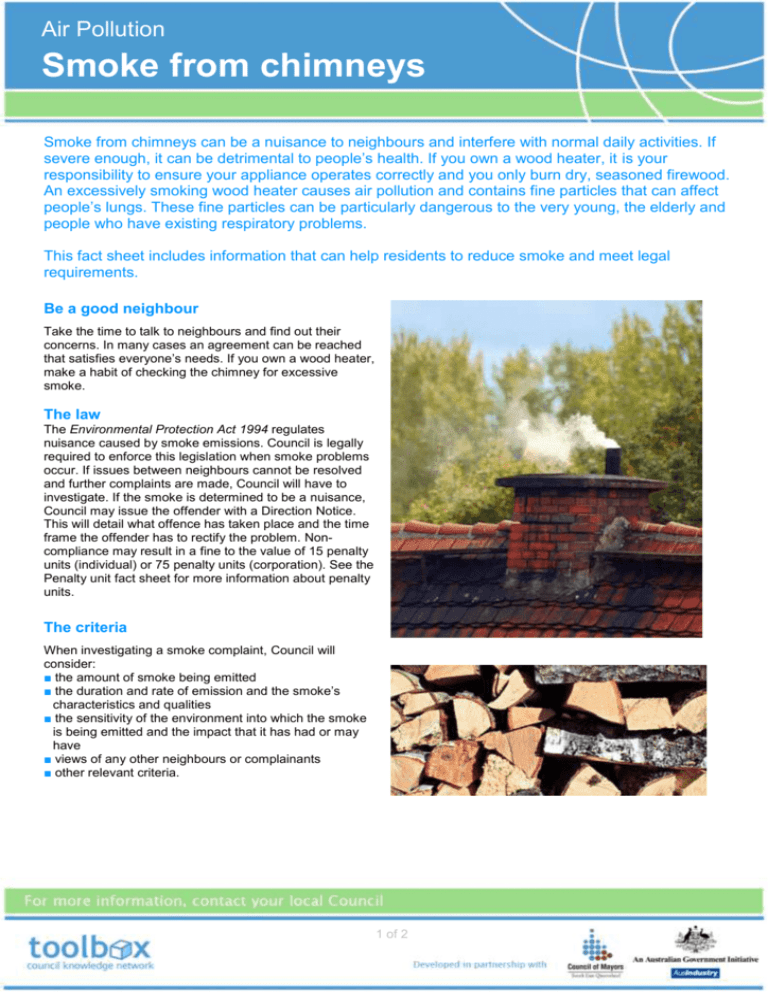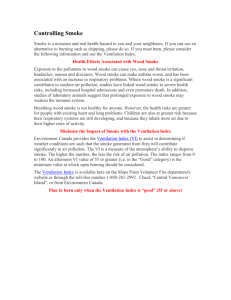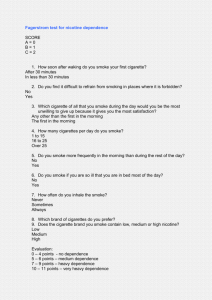Smoke from chimneys (Word 941KB)
advertisement

Air Pollution Smoke from chimneys Smoke from chimneys can be a nuisance to neighbours and interfere with normal daily activities. If severe enough, it can be detrimental to people’s health. If you own a wood heater, it is your responsibility to ensure your appliance operates correctly and you only burn dry, seasoned firewood. An excessively smoking wood heater causes air pollution and contains fine particles that can affect people’s lungs. These fine particles can be particularly dangerous to the very young, the elderly and people who have existing respiratory problems. This fact sheet includes information that can help residents to reduce smoke and meet legal requirements. Be a good neighbour Take the time to talk to neighbours and find out their concerns. In many cases an agreement can be reached that satisfies everyone’s needs. If you own a wood heater, make a habit of checking the chimney for excessive smoke. The law The Environmental Protection Act 1994 regulates nuisance caused by smoke emissions. Council is legally required to enforce this legislation when smoke problems occur. If issues between neighbours cannot be resolved and further complaints are made, Council will have to investigate. If the smoke is determined to be a nuisance, Council may issue the offender with a Direction Notice. This will detail what offence has taken place and the time frame the offender has to rectify the problem. Noncompliance may result in a fine to the value of 15 penalty units (individual) or 75 penalty units (corporation). See the Penalty unit fact sheet for more information about penalty units. The criteria When investigating a smoke complaint, Council will consider: ■ the amount of smoke being emitted ■ the duration and rate of emission and the smoke’s characteristics and qualities ■ the sensitivity of the environment into which the smoke is being emitted and the impact that it has had or may have ■ views of any other neighbours or complainants ■ other relevant criteria. 1 of 2 Smoke from chimneys Fact Sheet Reducing smoke emissions Other things to consider Choose your firewood carefully The dryness of firewood makes all the difference to the amount of smoke emitted from a chimney. Wet or green wood causes excessive smoke and doesn’t generate as much heat. Dry wood is generally lighter in colour and should make a hollow cracking sound when banged together. Wet or green wood is heavier and usually darker in colour. Do not use wood products such as chipboard, as they contain formaldehyde, or treated or painted timber, as the smoke from these products is hazardous to people’s health. Before you buy a wood heater Stack wood under cover in a dry ventilated area Consider the potential impacts that a wood heater may have on your neighbours. If you decide to purchase a wood heater, ensure that it is the correct size. A heater too large for a home will need to be turned down, reducing its efficiency and causing excessive smoke. Make sure that the heater is constructed and installed correctly and meets the Australian Standards (AS4013 and AS2918). Wood should be air-dried for at least eight months before burning. Keep wood under cover and stack in a crisscross manner to allow air to circulate. Burn the fire brightly Smoke from a wood heater is a difficult problem to resolve because most of them (regardless of their type and technology) will tend to emit smoke at different times. Fires and wood heaters in residential areas which are in close proximity to other homes will nearly always cause nuisance on a still winter’s night compared with those in rural areas which are often a considerable distance from other dwellings, resulting in the possible ‘dilution’ of smoke. Start with dry kindling and fully open the air controls. Do not use oil or fuel soaked rags. Once the fire is well established, gradually add larger wood pieces, making sure not to choke the fire by overloading it with logs. An efficient fire should have bright swirling flames and red glowing embers with little or no smoke coming from the chimney. Insulation Keep air controls open at night Consider other heating alternatives such as gas heaters, which are clean burning, cost effective and less polluting. By having a properly insulated house, the need for heating will be reduced. Ensure that ceiling insulation is in place, draughts are blocked, doors are closed to unoccupied rooms and curtains are drawn to keep heat in. Alternative heating methods Avoid shutting down the air controls (damper) overnight as this also causes excessive smoke. Let the fire burn out completely overnight – an insulated house should hold enough heat to keep your house warm until morning. Check your chimney All wood heaters tend to smoke when first lit. However, the smoke should not last for more than 15 minutes. Regularly check the chimney, and if it is smoking too much, reduce the fuel load and open the airflows. Cleaning and maintaining your chimney Clean and maintain your chimney and wood heater regularly, especially at the beginning and end of winter. Regularly check the glass door for cracks and door ropes and seals for deterioration. Check the firebox for rust and lubricate the air-slide control with high temperature grease. 2 of 2






